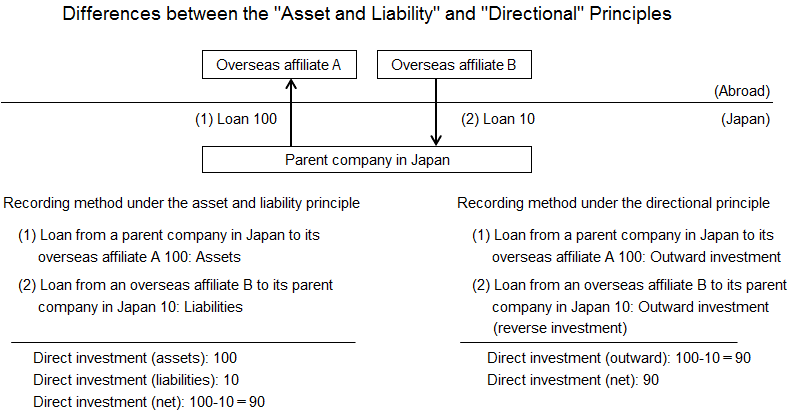Recording Principles of Direct Investment
June 2021
In Japan's balance of payments related statistics, direct investment data are compiled based on either the asset and liability principle or the directional principle. The recording principles used for the different statistics are as follows.
| Statistics | Recording principle | General description |
|---|---|---|
|
Asset and liability principle | Investments of Japanese companies in foreign companies are classified as "assets" and investments from foreign companies to Japanese companies are classified as "liabilities." For direct investment income, receipts of dividends etc. by Japanese companies from foreign companies are recorded as "credit" and payments of dividends etc. from Japanese companies to foreign companies are recorded as "debit." |
|
Directional principle | Based on where the parent companies reside, investments of a Japanese company in an overseas affiliate are classified as "outward investment" and investments from a foreign company to a Japanese affiliate are classified as "inward investment." For example, investments from an overseas affiliate to its parent company in Japan are not recorded under inward investment but recorded as reverse investments, namely withdrawals by the parent company, under outward investment. |
- Note:1 These statistics are available on the MOF website (link to an external website).
While gross assets and liabilities are shown under the asset and liability principle, "investments from an affiliate to its parent company (i.e., reverse investments)" are deducted from "investments from a parent company to its affiliate" under the directional principle. The following example illustrates the differences in the methods of recording debt instruments (loans) under the two principles.
Example: A parent company in Japan lends 100 to its overseas affiliate A and borrows 10 from its overseas affiliate B.
Under the asset and liability principle, the loans of 100 and 10 are recorded under assets and liabilities, respectively. In contrast, under the directional principle, the loan of 100 is recorded under outward investment, while the loan of 10 is recorded as a reverse investment, that is, a withdrawal by the parent company, under outward investment. Thus, the amount of outward investment is 90 in total (by partner economy, however, outward investments of 100 in the economy in which A resides and outward investments of minus 10 in the economy in which B resides are recorded). Under both principles, the value of net direct investment is 90.

